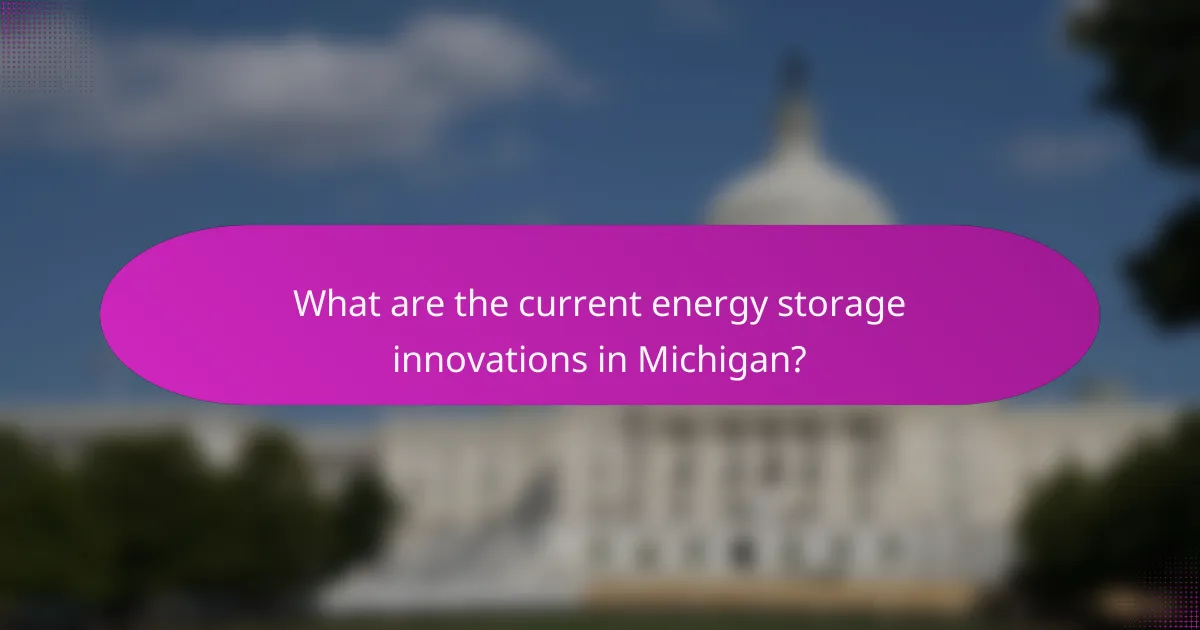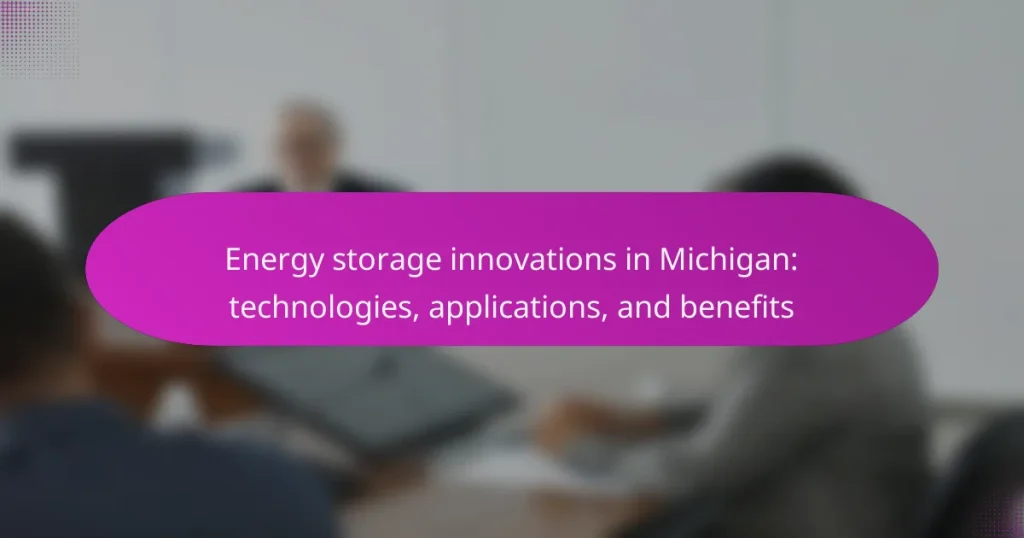
What are the current energy storage innovations in Michigan?
Current energy storage innovations in Michigan include advanced battery technologies and grid-scale energy storage systems. Companies like General Motors and Ford are developing electric vehicle batteries with improved energy density and longevity. The Michigan Energy Innovation Business Council reports increased investment in energy storage solutions. Additionally, projects like the DTE Energy’s 1.5 MW battery storage system enhance grid reliability. The state is also exploring pumped hydro storage as a method to balance energy supply and demand. Recent initiatives focus on integrating renewable energy sources with storage technologies. These innovations aim to reduce carbon emissions and improve energy efficiency across the state.
How do these innovations contribute to energy efficiency?
Energy storage innovations in Michigan enhance energy efficiency by optimizing energy usage and reducing waste. These technologies enable the storage of excess energy generated during low-demand periods. This stored energy can be utilized during peak demand times, minimizing reliance on fossil fuel power plants. For example, advanced battery systems can store renewable energy from solar and wind sources. According to a study by the Michigan Energy Innovation Business Council, these innovations can lead to a 20% reduction in energy costs for consumers. Additionally, they help stabilize the grid by balancing supply and demand. Overall, these innovations facilitate a more sustainable energy ecosystem in Michigan.
What specific technologies are being developed in Michigan?
Michigan is developing several specific technologies in the energy storage sector. These include advanced battery systems, particularly lithium-ion and solid-state batteries. Researchers are also focusing on flow batteries, which offer scalable energy storage solutions. Additionally, Michigan is exploring grid-scale energy storage technologies to enhance renewable energy integration. Companies in the state are working on innovative energy management systems that optimize storage use. The Michigan Energy Innovation Business Council reports significant investments in these technologies. Furthermore, collaborations between universities and industry are fostering research in energy storage advancements.
How do these technologies differ from traditional energy storage methods?
Innovative energy storage technologies differ from traditional methods primarily in their efficiency and scalability. Traditional energy storage, such as lead-acid batteries, often has lower energy density and shorter lifespans. In contrast, newer technologies like lithium-ion and flow batteries offer higher energy densities and longer cycle lives. For instance, lithium-ion batteries can achieve 150-200 Wh/kg, whereas lead-acid typically provides around 30-50 Wh/kg.
Additionally, modern technologies often feature faster charging times and enhanced safety mechanisms. Traditional systems may require extensive maintenance and have limited operational ranges. Newer solutions can operate in a wider range of temperatures and conditions.
Furthermore, innovative energy storage technologies often integrate with renewable energy sources more effectively. They can respond rapidly to fluctuations in energy supply and demand, supporting grid stability. Traditional methods are generally less adaptable to such dynamic energy environments.
Overall, the advancements in energy storage technologies lead to improved performance, reliability, and integration capabilities compared to traditional methods.
What applications are emerging from these energy storage innovations?
Emerging applications from energy storage innovations include renewable energy integration, electric vehicle charging, and grid stability. Energy storage systems facilitate the use of solar and wind power by storing excess energy for later use. This improves the reliability of renewable energy sources. Additionally, energy storage supports electric vehicle infrastructure by providing fast charging capabilities. It enhances grid stability by balancing supply and demand during peak usage. According to the U.S. Department of Energy, energy storage technologies can reduce grid congestion and improve overall energy efficiency. These applications are critical for advancing Michigan’s energy transition.
How are businesses utilizing energy storage solutions in Michigan?
Businesses in Michigan are utilizing energy storage solutions to enhance energy efficiency and reliability. These solutions allow companies to store excess energy generated during peak production times. This stored energy can be used during high-demand periods, reducing reliance on the grid. Many businesses are integrating battery systems to manage energy costs effectively. For example, commercial solar installations often pair with battery storage to optimize energy use. The Michigan Energy Storage System (MESS) initiative supports these implementations. Additionally, businesses benefit from incentives provided by state programs aimed at promoting renewable energy. This strategic use of energy storage solutions contributes to sustainability efforts and cost savings.
What role do energy storage systems play in renewable energy integration?
Energy storage systems are crucial for renewable energy integration. They balance supply and demand by storing excess energy generated during peak production times. This stored energy can be released when production is low or demand is high. For instance, batteries can store solar energy generated during the day for use at night. According to the U.S. Department of Energy, energy storage can enhance grid reliability and resilience. It also facilitates the use of more renewable sources, minimizing reliance on fossil fuels. By enabling time-shifting of energy, storage systems improve overall efficiency in energy use.
What are the benefits of energy storage innovations in Michigan?
Energy storage innovations in Michigan provide several key benefits. They enhance grid reliability by storing excess energy for later use. This reduces the risk of outages during peak demand periods. Energy storage also facilitates the integration of renewable energy sources like wind and solar. It allows for better management of energy supply and demand. Additionally, these innovations can lower energy costs for consumers. According to a report from the Michigan Energy Innovation Business Council, energy storage can help reduce electricity prices by minimizing the need for expensive peak power generation. Overall, energy storage innovations contribute to a more resilient and sustainable energy system in Michigan.
How do these innovations impact the local economy?
Energy storage innovations in Michigan positively impact the local economy by creating jobs and enhancing energy reliability. These technologies lead to the establishment of new companies focused on energy solutions. Job creation in manufacturing, installation, and maintenance of energy storage systems stimulates economic growth. Increased energy reliability reduces costs for businesses and consumers, fostering a more stable economic environment. Furthermore, energy storage solutions enable the integration of renewable energy sources, attracting investments in clean technology. According to a report by the Michigan Energy Innovation Business Council, the clean energy sector has seen significant job growth, contributing to a more robust local economy.
What environmental benefits are associated with energy storage technologies?
Energy storage technologies provide significant environmental benefits. They enhance the integration of renewable energy sources like wind and solar. By storing excess energy, they reduce reliance on fossil fuels during peak demand. This leads to lower greenhouse gas emissions. Energy storage also helps stabilize the grid, minimizing the need for backup power plants. According to the U.S. Department of Energy, energy storage can reduce emissions by up to 80% in certain scenarios. Additionally, these technologies contribute to more efficient energy use, decreasing overall environmental impact.
How are Michigan’s energy storage innovations influencing policy and regulation?
Michigan’s energy storage innovations are significantly influencing policy and regulation by promoting renewable energy integration and enhancing grid reliability. The state has implemented policies that encourage the development of energy storage systems, such as the Clean and Renewable Energy and Energy Waste Reduction Act. This act aims to facilitate the deployment of energy storage technologies alongside renewable resources. Furthermore, Michigan’s energy storage initiatives are driving regulatory changes that address interconnection standards and cost recovery mechanisms for storage projects. The Michigan Public Service Commission has been actively involved in creating frameworks that support the growth of energy storage solutions. These regulations aim to streamline the approval processes for energy storage installations, ensuring they can be integrated efficiently into the existing grid. As a result, energy storage innovations are shaping a more resilient energy landscape in Michigan, aligning with the state’s broader goals for sustainability and energy independence.
What initiatives are being implemented to support energy storage development?
Various initiatives are being implemented to support energy storage development in Michigan. The Michigan Energy Storage Initiative aims to accelerate the deployment of energy storage technologies. This initiative focuses on research, development, and commercialization of energy storage systems. The state government has also established funding programs to support energy storage projects. Additionally, partnerships with universities and private sectors are fostering innovation in energy storage solutions. The Michigan Public Service Commission is promoting regulatory frameworks that encourage energy storage integration. These efforts are designed to enhance grid reliability and support renewable energy sources.
How do regulations affect the adoption of new energy storage technologies?
Regulations significantly influence the adoption of new energy storage technologies. They can either facilitate or hinder market entry for innovative solutions. For instance, supportive regulations may provide financial incentives or grants to encourage investment in energy storage. In contrast, stringent regulations can impose high compliance costs or lengthy approval processes.
In Michigan, the regulatory framework allows for pilot projects and testing of new technologies. This encourages companies to innovate and deploy energy storage systems. Additionally, regulations that mandate renewable energy integration can drive the demand for storage solutions.
Evidence shows that states with favorable policies have seen increased adoption rates of energy storage technologies. According to a report by the U.S. Department of Energy, states with clear regulatory pathways for energy storage have experienced a 50% increase in installations over five years.
What challenges do energy storage innovations face in Michigan?
Energy storage innovations in Michigan face several challenges. These include high initial costs associated with advanced technologies. Limited infrastructure for widespread deployment is another significant barrier. Regulatory hurdles impact the integration of energy storage into existing systems. Additionally, the lack of standardized policies can create uncertainty for investors. Seasonal weather variations affect the efficiency of storage systems. Finally, competition from traditional energy sources can hinder the adoption of new storage solutions.
How can these challenges be addressed for future advancements?
Investment in research and development can address challenges in energy storage innovations. Increased funding can lead to breakthroughs in battery technology. Collaborations between universities and industry can accelerate innovation. Policy support can create a favorable environment for new technologies. Incentives for renewable energy integration can enhance energy storage applications. Public-private partnerships can facilitate resource sharing and expertise. Education and training programs can build a skilled workforce for the energy sector. Finally, pilot projects can demonstrate feasibility and attract further investment.
What lessons have been learned from existing energy storage projects?
Existing energy storage projects have revealed several key lessons. Firstly, project scalability is crucial for economic feasibility. Projects like Tesla’s Hornsdale Power Reserve in Australia demonstrate that larger systems can achieve lower costs per unit of energy stored. Secondly, reliability in grid integration is essential. Successful projects highlight the importance of seamless interaction with existing grid infrastructure. Thirdly, diverse technology applications enhance performance. Hybrid systems combining battery storage with other technologies have shown improved efficiency. Lastly, regulatory frameworks must adapt. Projects have encountered challenges due to outdated regulations that do not accommodate new technologies. These insights guide future energy storage initiatives, ensuring better planning and execution.
What are the future trends for energy storage in Michigan?
Future trends for energy storage in Michigan include increased use of lithium-ion batteries and advancements in grid-scale storage solutions. The state is focusing on integrating renewable energy sources, such as wind and solar. This shift will require enhanced storage capabilities to manage supply and demand fluctuations. Additionally, there is a growing interest in exploring alternative technologies, such as flow batteries and solid-state batteries. Michigan’s energy policies are also encouraging investment in energy storage infrastructure. The expansion of electric vehicle adoption will further drive the need for robust energy storage systems. These trends align with national goals for reducing greenhouse gas emissions and promoting energy independence.
How is research and development shaping the future of energy storage?
Research and development is significantly shaping the future of energy storage by driving innovations in battery technology. Advances in materials science are leading to the creation of batteries with higher energy densities and faster charging capabilities. For example, lithium-sulfur and solid-state batteries are being researched for their potential to outperform traditional lithium-ion batteries. These innovations can increase the lifespan and efficiency of energy storage systems. Additionally, R&D is focusing on reducing costs associated with energy storage solutions. According to a report from the International Energy Agency, the cost of lithium-ion batteries has dropped by over 80% since 2010. This trend is expected to continue, making energy storage more accessible for various applications. Furthermore, research into recycling and sustainability of battery materials is gaining momentum, addressing environmental concerns linked to battery production and disposal. Overall, ongoing research and development efforts are crucial for enhancing energy storage technologies, making them more efficient, affordable, and environmentally friendly.
What emerging technologies should we watch for in the coming years?
Emerging technologies to watch for in the coming years include solid-state batteries, advanced energy storage systems, and artificial intelligence in energy management. Solid-state batteries promise higher energy density and safety compared to traditional lithium-ion batteries. Advanced energy storage systems, such as flow batteries, offer longer discharge times and scalability for renewable energy integration. Artificial intelligence can optimize energy usage and storage, improving efficiency and reducing costs. These technologies are critical for enhancing energy storage solutions in Michigan, supporting the state’s transition to renewable energy sources and sustainability goals.
What practical tips can be implemented for optimizing energy storage solutions?
To optimize energy storage solutions, consider implementing advanced battery management systems. These systems enhance performance by monitoring battery health and optimizing charge cycles. Use energy management software to analyze consumption patterns. This software can forecast energy needs and adjust storage accordingly. Incorporate renewable energy sources to charge storage systems. This approach reduces reliance on grid energy and lowers costs. Utilize modular storage systems for scalability. Modular systems allow for easy upgrades as energy demands change. Regularly conduct maintenance checks to ensure efficiency. Scheduled maintenance can prevent degradation and extend the lifespan of storage systems.
How can businesses assess their energy storage needs effectively?
Businesses can assess their energy storage needs effectively by analyzing their energy consumption patterns. They should evaluate peak demand periods and energy usage over time. This data helps in identifying the required storage capacity. Additionally, businesses must consider their operational hours and energy cost fluctuations.
Conducting a cost-benefit analysis of different energy storage technologies is crucial. This analysis should include factors like installation costs, maintenance, and potential savings. Businesses can also consult energy experts for tailored assessments.
Utilizing software tools for energy management can provide insights into storage requirements. These tools can simulate various scenarios and predict energy needs. In Michigan, businesses can refer to state-specific guidelines and incentives for energy storage solutions.
What best practices should be followed for maintaining energy storage systems?
Regular monitoring is essential for maintaining energy storage systems. This involves checking voltage levels, temperature, and overall system performance frequently. Proper ventilation is crucial to prevent overheating. Keeping the storage area clean reduces the risk of dust accumulation, which can affect performance. Regularly updating software ensures optimal operation and security. Performing scheduled maintenance checks can identify potential issues before they escalate. Following manufacturer guidelines for maintenance schedules is important for longevity. Documenting maintenance activities helps track performance and issues over time. These practices enhance reliability and efficiency in energy storage systems.
Energy storage innovations in Michigan encompass advanced battery technologies and grid-scale systems aimed at enhancing energy efficiency and reliability. Key developments include electric vehicle batteries with improved energy density, pumped hydro storage, and integration of renewable energy sources. The article outlines the benefits of these innovations, such as reduced carbon emissions, lower energy costs, and positive impacts on the local economy. Additionally, it addresses the challenges faced in the sector, emerging technologies, and best practices for optimizing energy storage solutions. Overall, these advancements play a critical role in Michigan’s transition to a more sustainable energy ecosystem.


